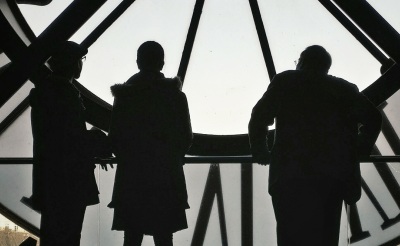5 regulatory mistakes to avoid
Don't give it all away nor ask for the world
 This post is brought to you by one of our information partners, Proven Reserves Exploitation Ltd.
This post is brought to you by one of our information partners, Proven Reserves Exploitation Ltd.
Without AppIntel, how would you know about the hidden policies of the regulator when submitting applications? AppIntel helps you find all the closed applications like the one you want to submit.
If you're submitting your own application to the regulator, you'll want to know about these five mistakes to avoid. Part of a bigger list we use at Proven Reserves, it can help you get started.
1. Don't show your dirty laundry
Whatever you do, you don't want to flag a compliance issue when you apply to the regulator. The regulator is not your friend. They are the police of the oil and gas industry. They are always looking for infractions.
It's like the old joke:
A policeman walks up to a patron at the bar and asks, "Is that your green pickup parked outside?"
"No shir, offisher," was the quick, but unsteady reply. "That pickup'sh not mine. That pickup'sh shtolen."
 After you've written application, go back through it with the question in mind, What did I write that could expose some non-compliance? Try to forget your pride of ownership and focus on the person who will read your application at the regulator.
After you've written application, go back through it with the question in mind, What did I write that could expose some non-compliance? Try to forget your pride of ownership and focus on the person who will read your application at the regulator.
Be careful not to expose a compliance issue in your application. Recently an applicant thought he was submitting a straightforward modification to a satellite installation. But he was surprised when it was automatically refused and the facility was referred to the regulator's compliance department. Now he might face noncompliance issues on the existing installation.
2. Don't submit too little information
Don't give the regulator too little data. If you give them too little, you'll be bogged down forever in supplemental information requests.
Supplemental information requests (SIRs) are sent by the regulator when they are looking for something you didn't supply. Some applicants think that rounds of SIRs are a fact of life for certain big applications. But that's not true. You can get very difficult applications approved without any SIRs if you include all the information they need.
Some initial SAGD applications took four years to approve because of deficiencies. Every time a SIR was sent by the regulator, the applicant was surprised and spent several months putting together a careful reply. Many rounds of SIRs meant a great delay in their project.
Study the directives, guides, and checklists that govern your application. That's a good starting point. However, the checklists only ask for data. They don't usually tell you why the regulator wants the data.
It's very important to see a regulatory application from the regulator's point of view. Anticipate what they want to see. Anticipate what they need to know. Then plan to give them just enough information to make it easy for them to approve.
The very best way to ensure you don't submit too little information is to look at the poor applications of others. Poor applications are applications that were closed (read refused) by the regulator.
Poor applications also include applications that took a long time to approve. Long approval time usually indicates that the initial application was deficient in important ways.
At Proven, we've had many difficult applications approved quickly. And we've seen easy applications refused by the regulator. The difference is the quality of the application, and rarely the difficulty of the request.
?subject=Audit my application&body=Will you audit my application before I submit it? %0D%0A%0D%0AMy Name:__________ %0D%0AMy Phone Number:__________ %0D%0A%0D%0AType of my application____________%0D%0AI need to submit it by _____________%0D%0A%0D%0A(Or call Proven Sales at 403-803-2500.)">Contact Proven to audit your application before you submit. We read between the lines in the regulations.
3. Don't include too much information
Make sure you don't give too much information to the regulator when you submit an application.
Giving too much is a bad idea for three reasons. First, the regulator staff will process everything you give them and that makes their approval process longer. Second, you may unwittingly expose a compliance issue that will cause significant regulatory pain. And finally, you expose all your maps and data to the public domain immediately.
Regulatory staff are usually detail oriented people. If you give them interesting data that they don't need, they won't ignore it, they will review it and struggle about why it's relevant to the request your making. That extra review, takes extra time. By giving them information they don't need, you are making their job harder, not easier.
In a recent application, this operator showed mapping and data that had been used in a simulation -- but she neglected to show the mapping required by the regulator. This is the worst of both worlds. She exposed too much information to the world and she'll also face information supplemental information requests.
4. Don't ask for the world
 Too many applicants think they should ask for every piece of regulatory permission all at once. Then they can get all the compliance issues out of the way and get on with the real work of oil and gas.
Too many applicants think they should ask for every piece of regulatory permission all at once. Then they can get all the compliance issues out of the way and get on with the real work of oil and gas.
But this never works.
Energy regulators see their approval as a precious commodity. It's something to be rationed and consumed a little bit at a time. They think that once an approval is given, it's painful (but not impossible) to rescind.
Don't try to go from zero to hero in one application.
5. Don't give away the farm
Always use any contour options available to map your pool onto your own land. Any geological or geophysical data you add to an AER application is in the public domain the minute you apply.
When they apply to the regulator, many oil and gas professionals give away too much geological and geophysical information.
When an operator places his net pay map in an application, it immediately becomes part of the public domain. He is tipping his hand to the industry. If there is part of this net pay that is mapped off his land, he's practically begging for competitors to put another straw in his pool through a corner shot.
There are many, many low risk corner shots showing in application net pay maps just waiting to be exploited. These net pay maps exist back in history in many applications.
?subject=Show me how to find corner shots in my neighbor's net pay maps.&body=Please show me an AppIntel demo on how to find corner shots in my neighbor's net pay maps. %0D%0A%0D%0AMy Name:__________ %0D%0AMy Phone Number:__________ %0D%0A%0D%0A(Or call Proven Sales at 403-803-2500.)">Contact us to find out how through AppIntel.
And one more bonus idea for getting your application approved
Make sure you tell the regulator what to think about your data. I know it's tough for engineers to think this way. Most of us think that if you present convincing data, people will come to the same conclusion you made -- you don't need to baby someone though the thinking. But this expectation of "guess what I'm thinking" never works with the regulator. They are looking for key information different than you. They see things different that you. Tell them what conclusion they should draw from your data. And tell them up front. And tell them often.
For example, never caption a figure, Pressure vs Depth. A much better caption: The Bluesky zone is underpressured, or
Because of good cap rock seal, no high pressure fluids have escaped the injection zone.
You get the idea.
We've given you five ideas on things to avoid in your applications (and one bonus idea). In fact, this is only part of the list. At Proven, we've identified 34 issues that could cause your application to get stuck at the regulator. We use 42 strategies to make sure they don't.
?subject=Help me submit my application&body=Tell me about Proven's advise and audit service to cheaply leverage your expertise.%0D%0A%0D%0AMy Name:__________ %0D%0AMy Phone Number:__________ %0D%0A%0D%0AApplication type: _________%0D%0A%0D%0A(Or call Proven Sales at 403-803-2500.)%0D%0APricing: http://proven-reserves.com/regulatory.php">Contact Proven for expert advice on approvals.
Make sure you read our next blog post, Closed applications -- painful and expensive.
Tags: AER application, AppIntel advantage
6 Oct 2021

AI predicts the future for 2026
using leading indicators

Celebrating 2025, a year of innovation
Oil and gas paradigm shifts this year

RTF: Most refused submission type in November
Leading indicators from industry

Astrobleme impacts deep well disposal scheme
Learn from the experience of other operators

Non-meridian thermal wells
Still drilling horizontal wells N‑S? Why?

Steam surfactant co-injection
Want to win? What is your competitive advantage?

Surprise! Sour gas production from a sweet thermal scheme
Dealing with surprises in the oil and gas industry. What to do next.

10 ways to increase production before Christmas - Infographic
For your wall to remind you

10 ways to increase production before Christmas
Each cost less than half a million

Using AI to reduce risk of oil and gas failure
How can you assess the risk without knowing the epic fails?

Artificial intelligence using vetted oil and gas information
Using anything else is dangerous

Your AI search history is being sold to your competitors
Your use of AI is not free

Smarter acquisitions
Video demo on using the KiP box for acquisitions

AI alerts increase the speed of innovation
AI launches oil and gas operators from rival wins

Elusive promise of ASP flooding
This one's ending

SAGD Blowdown Experiment
Shows his unexpected results

Selfie-mail: emails to myself
I send more emails to myself than to any other person.




 Calgary, Alberta, Canada
Calgary, Alberta, Canada
 Share
Share